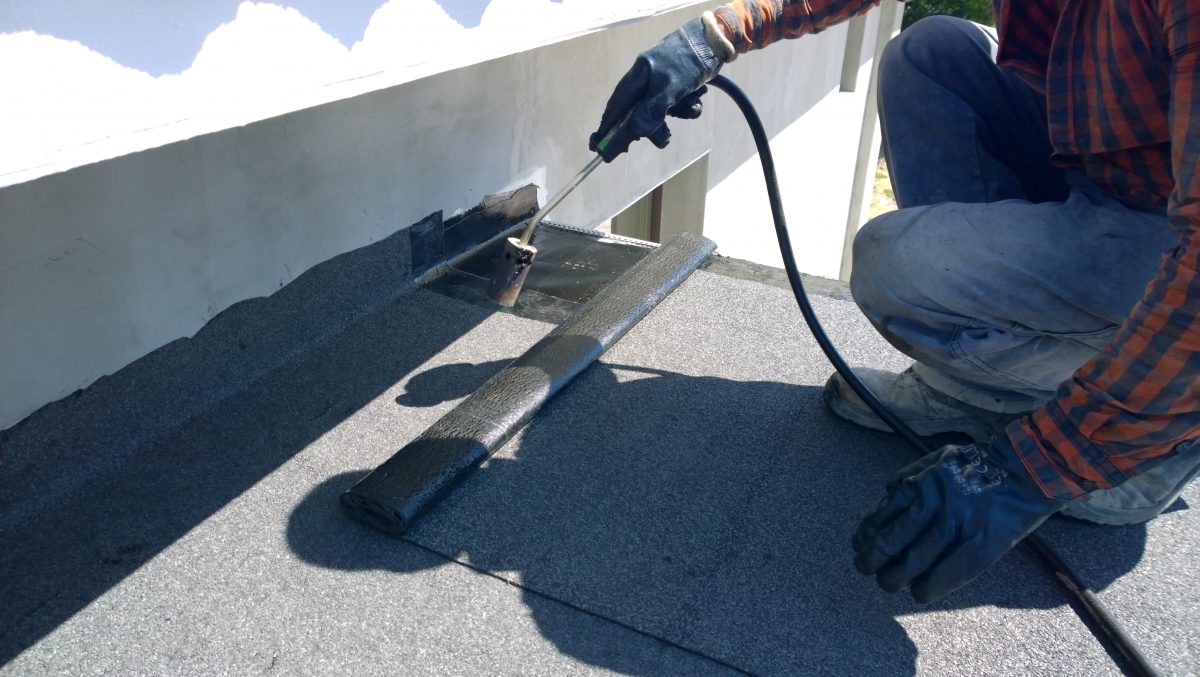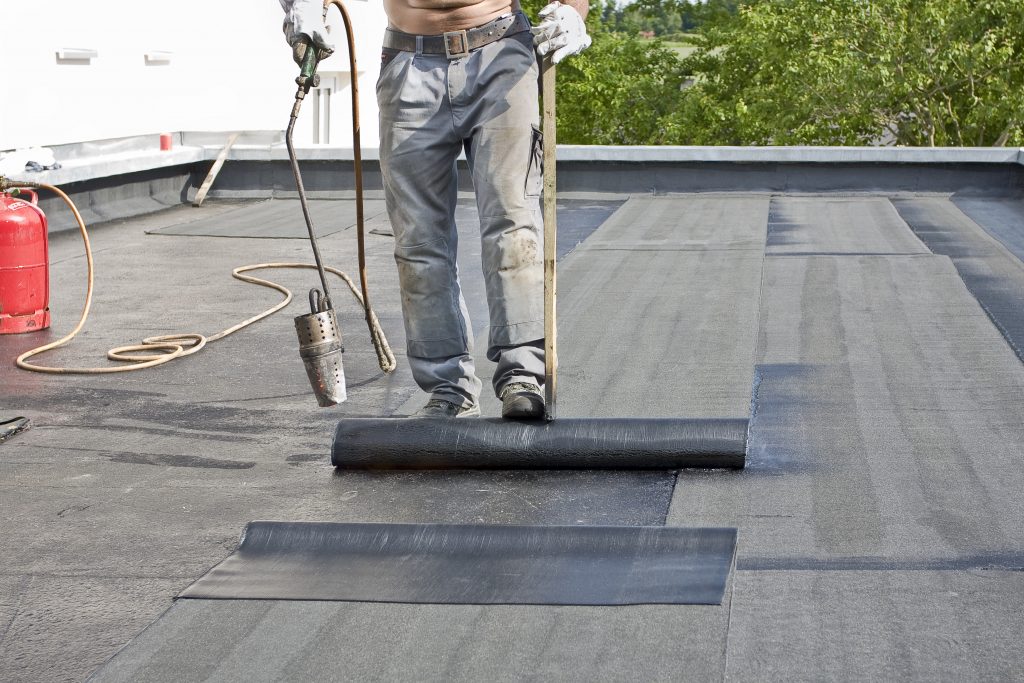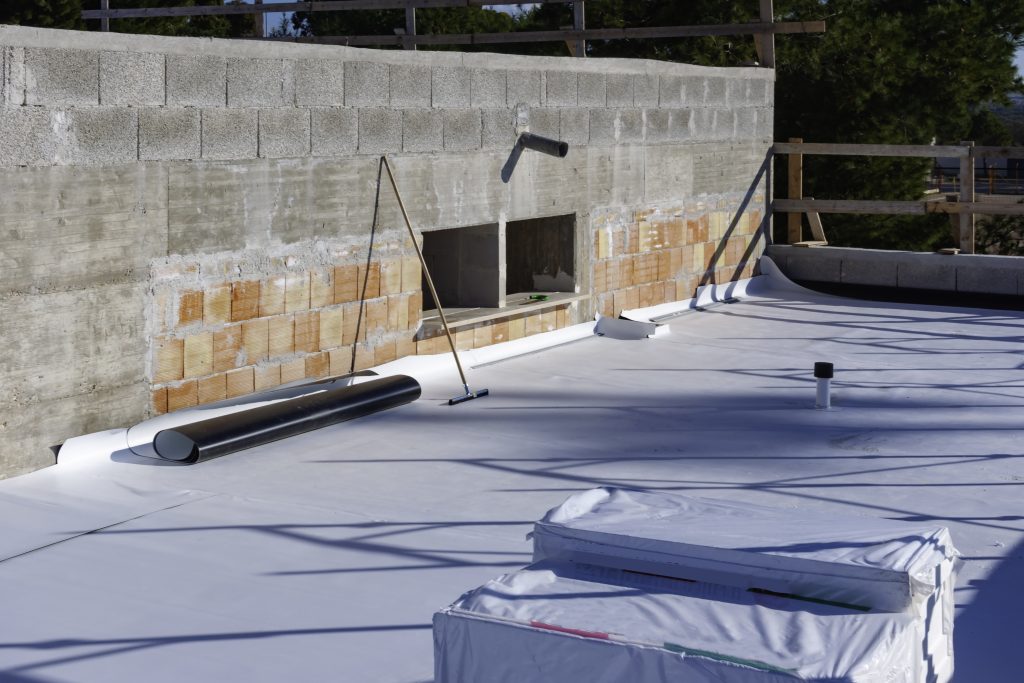
25 Oct Flat Roof Replacement Cost: Why You Need to Replace Your Flat Roof
Getting excellent and affordable flat roof replacement cost in Canada is very rare and sometimes tasking. However, this task becomes easier when you understand why it is vital to replace your flat roof. After all, it is the reason why you need to bother with a flat roof replacement cost in the first place.
We all want to get the best possible deal when it comes to spending our hard-earned money. However, some items fall in the “never bargain” category. A new flat roof ranks pretty high on that list.
Having a roof over your head is a basic, essential need. However, a typical homeowner will either pay too much or, inadvertently, opt for a low-quality roof. Some prefer to hire a roofing contractor with the lowest bid, while some have little knowledge of flat roof replacement cost.
Trying to estimate your flat roof replacement cost can feel overwhelming and challenging sometimes. To make the process easier, we’ve compiled a guide explaining the replacement costs for several different roofing materials and styles. That’s not all. We will also discuss in detail the reasons why you may have to replace your flat roof. Keep reading to find out more about flat roof replacement costs in Toronto.
Related article: Flat Roof Replacement Cost: All You Need To Know
What are flat roofs?
Flat roofs date back to 2000 BC, during the Minoan period. In those days they were constructed of timber or thatching to block out the harsh rays of the sun.
A flat roof is basically a membrane without a slope placed on top of a building. This membrane is made of various waterproof materials, depending on the type of flat roof. The common factor between all of them is that they all used the roof felt as a base. The membrane hangs over a sort of structural deck. In between the floor and the flat roof is a vapour barrier.
The vapour barrier is a material that prevents moisture from building up and developing in the flat roof layers. Metal flashing is also used to seal the edges. On a flat roof, water is directed away from the roof into small gutters that drain the water off the roof.
Before installing a flat roof, it is worth considering the cost and the maintenance factor. While the cost of installing a flat roof is affordable, it requires regular maintenance efforts over the years.
Flat roofing in Toronto is recommended for people who are looking to use the extra space and versatility that a flat roof offers.
Merits of a Flat Roof
There are many advantages that you can enjoy from a flat roof. These distinct advantages separate flat roofing from other roof types available in Toronto.
Cost
Constructing a flat roof usually takes less time and requires fewer materials than a traditional roof. This also means it costs less to install.
Warmth
Flat roofs can keep your home considerably warmer than their competitors, especially during the cold winter months. This is because the flat surface area absorbs heat from the sun. This is why it is recommended for the cold climate of Toronto.
Versatility
Flat roofs offer a versatile use of internal and external space. It can be used as a patio, garden, outdoor swimming pool, or a communal outside area.
Accessibility
Flat roofs are more accessible, making them an easier prospect for new installations and repairs.

Why Flat Roofs?
Before we get into different types of flat roofing materials, it’s essential to know why they exist in the first place. There are two main reasons why a contractor would opt for a flat roof. It could be either for aesthetic purposes or due to convenience.
For example, when you’re adding structures to an already existing building, a flat roof looks nicer. Homes with unblended roof pitches can be an awkward eyesore.
In commercial buildings, flat roofs, outright, offer a more convenient place to install outdoor HVAC units rather than putting them in high-traffic ground areas.
Of course, any roof’s main job is to create a barrier of protection between the building and the atmosphere. Therein lies the problem associated with flat roofing and why flat roof replacement cost becomes an essential need.
For all the aesthetics and convenience, the design doesn’t do a lot to avoid snow and water buildup.
Flat roofs aren’t entirely ‘bubble-level’ flat. They work in much the same way as a gutter system, angled slightly, or pitched a couple of degrees so that water can flow into a downspout. Even so, flat roofing materials need to be able to absorb the brunt of the weather and to withstand ponding water or snow and ice until it melts.
Over time, the constant ponding and settlement of elements such as rain and snow can weaken flat roofing and cause leaks. Incessant leaks will mean that you have to replace your flat roof as soon as possible.
Types of Flat Roofs
Any material used to construct a flat roof must be watertight. Even though flat roofs are built on a slight incline, they are still very susceptible to leaks. That said, there are five main types of flat roofs. They include
Single-ply flat roof
Single-ply flat roofs are made from one layer of materials that are a bit like rubber. These materials cost less but are studier and more energy-efficient than roll asphalt roofs. Usually, single-ply roofs are made from EPDM, uPVC, ethylene and TPO. These are all mould resistant and low maintenance. Single-ply roofs typically last for up to 12 years.
Modified Bitumen flat roof
Some multi-ply flat roofs use a modified bitumen membrane, which is made from a mixture of polymers and asphalt. This makes them highly flexible and water-resistant. Usually, the top layer is covered with gravel to boost its durability. These types of flat roofs could last up to 20 years.
Multi-ply flat roof
This type of flat roof is made up of lots of layers of fibreglass, which is packed between layers of asphalt. The big benefit of multi-ply flat roofs is that they are reinforced, so they last longer and are less likely to get damaged. They can last as long as 30 years.
Flat-seamed metal flat roof
This is the most expensive type of flat roof, mainly because it is made of metal, such as copper and stainless steel. Metal flat roofs usually last between 20 and 50 years.
Roll asphalt flat roof
Roll asphalt flat roofing is made up of layers of asphalt coated fibreglass, tar, felt, and water-resistant materials, all of which are kept in place with nails or asphalt cement. The top layer is covered with gravel, which protects the roof from ultraviolet rays. This type of flat roof has been in existence for over a century and is generally the cheapest. However, it doesn’t usually last longer than ten (10) years.
Why you should replace your flat roof
Flat roofs, while possessing some advantages over sloped roofs, are susceptible to leaking in ways that sloped roofs are not. One of the critical weaknesses of flat roofs is the tendency to develop pooling. Pooling is defined as a condition in which water remains on a flat roof for more than 48 hours. This can significantly shorten the lifespan of a roof – or, even worse, the structural integrity of the building itself.
Some signs can help you know when to replace your flat roof and take the necessary action. The design of a flat roof makes it unique, and it may need extra care after it has served you for a long time. The flat roof is made in such a way that it cannot allow water to seep into the house. However, if the flat roof is in a poor state, it can let in water easily.
Some of the specific signs you should look out for to know that it is time for a flat roof replacement includes the following:
Time
One major factor that should inform your decision to incur flat roof replacement costs is the number of years since the roof was installed. Usually, it is advisable to replace a flat roof after ten years. After this time frame, normal tear and wear will set in and your flat roof will start leaking water.
Of course, the deterioration of a flat roof can be slowed down by proper maintenance. A built-up membrane flat roof can last up to 30 years even without regular maintenance. This is due to the granules inherent in it that protect the roof from weathering. Therefore, depending on the type of flat roof material you are using, you should replace your flat roof after 10 – 30 years of use.
Inefficient draining
Most flat roofs are made of waterproof membranes that contain a vapour barrier between the layer and the felt base. Sealing of the edges susceptible to leakages is done using metal flashing. In a bid to avoid excess water from gathering in a pool on the roof – your flat roof needs the gutter to drain water off the roof. You can know that it is time to replace your flat roof if the water does not drain adequately, and the edges have lost the sealant.
When this happens, the roof will develop holes, and your roof will experience leaks. Also, you may notice discolouring of the ceiling when you look up inside the house. This discoloration is often due to the moisture that has penetrated and built up under the layers.
You need to get your replacement equipment or call a contractor if you notice that the large roof panels are disintegrating. They will usually require a complete overhaul if you find it hard to put them back together.
Damaged vapour barrier
The vapour barrier of your flat roof should be extremely tight. If that is not the case, you may notice a buildup of moisture under your roof. If you take time to investigate, you will most likely find that the vapour barrier is torn and is ineffective in preventing water from entering.
You will also know that it is time to replace your flat roof when you notice that the top coating of your roof is not able to resist strong winds. On windy days, you may find that your roof may be producing a fluttering sound. This fluttering could expose the inner layers of your roof. Such exposure is a sure sign that the roof has served its purpose, and it is time for a new flat roof.
When the time comes to do the actual replacement, this time, you can reinforce the strength of your flat roof to improve its durability. The addition of a protective coat will give it the shield it requires against harsh weather.
Extensive pooling of water
The most significant issue with flat roofs is pooling. If your roof regularly develops pools of water, you should consider having it replaced.
Your roof drains should be in the best condition to avoid creating pools of water on your flat roof. Most flat roofs that are in good condition can withstand pools of water for up to 3 days. However, over time weak sections will start to develop where the water has pooled constantly.
There are some products on the market, such as roof slope, that can be used to add a pitch to your roof. This may be an option for eliminating roof ponding and may be an option depending on how extensive your roof damage may be.
Large rips and tears in the seam or material
Flat roofs may eventually develop cracks and holes in the roofing material. This issue is particularly likely to crop up along seams in the roofing. This is where two pieces of material were joined together.
If the damage is slight, a repair job may suffice. On the other hand, if the damage is extensive, you can be sure that other areas of the roof are probably close to failure.y You may be better off replacing the roof entirely.
Replace or repair: How do you decide?
When it comes to the dilemma of repairing or replacing flat roofing, it can be tough figuring out the best course of action. In the short-term, it is usually going to be cheaper to repair the roof. On the other hand, if your roof is bad enough, continuing to improve it becomes a never-ending exercise in futility. In fact, you can quickly end up spending more on repairs than you would have paid to replace the roof entirely. This is one of the reasons why understanding the rudiments of how to get a fair flat roof replacement cost is essential.
A good rule of thumb is that if the material with which your roof was constructed has reached the end of its service life, you should probably replace it instead of repairing it. It is only a matter of time until other problems develop. Also, if the cost of repair is going to exceed 20% of roof replacement cost and if the age of the roof is more than half of the expected service life of the material with which it is constructed, you should probably replace it. The likelihood of having to pay for additional repairs in the future is high enough to justify the other current outset.
Related article: Pros and Cons of Flat Roofing

Flat Roof Replacement Costs in Toronto
It’s easy to assume that a flat roof would be far less expensive to replace compared to a pitched one. For access reasons alone, it seems a lot easier to roof a flat surface than one that is steep and requires harnesses and braces to move around.
Many roofing contractors will tell you, though, that working on flat surfaces is harder on the back. Also, take into account that flat roofs often require the application of adhesives and material such as modified bitumen. Flat roof replacement also requires specialist knowledge such as the use of a sealing torch. All of these factors contribute to flat roof replacement costs. In fact, installation costs can be just as high for a flat roof as they would be a 10/12 pitch.
Labour prices will vary depending on your area. You can get a good idea of the estimated cost to cover your flat roof based on the average material prices.
PVC Membrane
Aside from the membrane itself, an insulation board must first be installed to help with energy costs. The layer is installed in rows (6-18′), each of which must be hot-air welded at the seams. Many contractors choose to mechanically fasten the edges to help prevent uplift, all of which contribute to labour costs. All in total, the installation of a PVC membrane costs roughly $7.00 to $11.00 per square foot.
EPDM Rubber
Manufacturers try to avoid seams with EPDM membrane sizes that can reach 50′ wide by 200′ long. These massive pieces are great for preventing possible leaks at the seams, but these wide rolls are also tough to handle during the installation.EPDM membranes install like a giant sticker, but this must be done slowly and with precision to avoid air bubbles. Typically, EPDM rubber costs between $4.00 and $8.00 per square foot installed.
TPO
Insulation boards are first fastened to the roof substrate. TPO also comes in rolls and can be mechanically fastened to the insulation boards or installed with the self-adhesive. Costs are approximately $5.00 to $8.50 per square foot installed.
Modified Bitumen
This is done in multiple layers, each of which is torched to the surface below at every quarterly turn of the roll. This is a very labour intensive process that absolutely must be performed by a professional. This type of roof does have cold-rolled technologies available now as well, but it involves a lot of application of roofing tar. Estimated costs are $3.00 to $6.00 per square foot installed.
Built-Up Roof
Installation includes applying multiple layers of ply sheets that are bonded together using hot asphalt. The top layer can be a reflective coating for energy efficiency or gravel for added durability. Costs range from $5.00 to $8.00 per square foot installed.
Spray-On Roof
Applying a spray to a roof sounds easy. The material can be used right over an existing roof, so little to no prep work is needed besides cleaning. It’s still important to apply the spray evenly and delicately, though.
The material itself will also determine the cost as polyurethane foam can be applied for as little as $3.00 per square foot and acrylic $6.00 per square foot.
Silicon is the agreed upon premier spray application, but the material costs can drive installation prices up to $6.00 to $11.00 per square foot or more.
Choosing an appropriate flat roofing material is a two-part process. Literally, you should choose a material that has excellent aesthetics and fits within your budget.
Factors Affecting the Cost of Roof Replacement
Roof replacement specialists believe that there are five primary factors that determine the cost of the replacement project. We will discuss these factors in this section
Type of Roof
When it comes to a commercial roof, there are two main varieties:
- Flat or Low Slope – A traditional choice for a roof that does not have much slope or grade.
- Sloped – The degree of slant or pitch is more in sloped roofs.
Typically, built-up bituminous or single-ply are the best roofing materials for a flat roof because of their durability and reliability. They are often less expensive and require less time to install when compared to other types of materials. Often, they come with a warranty for 15-25 years.
Roof Access
There are several factors regarding access to the roof, which may influence the replacement cost as much as the material used and the type:
- Height: The cost of a roof replacement for a 15-storey building will be more than that of a 5-storey structure due to the requirement of cranes and other machines to lift the roofing materials.
- Access to Property: The ability to get equipment and other materials close to the building and into the property will affect the cost of the project.
- Occupancy: An occupied building may pose additional challenges in the form of safety, productivity, and comfort for inhabitants. If work is required beyond the regular hours, it may incur extra costs.
- Storage Space for Materials: If extra space is required for storage, it will often result in an increased overall cost.
- Components Under the Roof: There is a combination of one or more of the following elements under every finished roof:
-
- The fundamental structure, which may be wood, metal, or concrete
- Cover board
- Insulation
- Other underlying materials
Wind Loads and Fastenings
Depending on where your building is located, the weather, and local codes of the area, you must decide the type of fasteners and wind loads your roof requires. If your region gets strong winds, you may need sturdy clamps at more frequent intervals.
Code Requirements of the Region
There are several regional, local, and provincial code requirements, such as structural efficiency, construction materials standards, and more, which you may have to consider. They can impact every aspect of your roof replacement project from underlying materials and insulation to slope and ventilation.

Flat Roof Repair and Maintenance
A typical flat roof repair job costs about $350 – $400 and involves locating sources of leaks and patching the seams or holes. However, depending on the severity of the damage, and the installed material type, repairing a flat roof can cost as much as $600-800 and above.
PVC membranes are easy to maintain and repair. Their heat-welded seams can be welded over and over again throughout their service life. This makes any repair, maintenance or modifications to install new equipment fast and simple.
Generally, repairing involves fusing a patch on the membrane over the hole that has been discovered. This may be classified as welding the source of a leak or re-welding a void in the seam.
If no leaks occur, it’s still recommended to re-seam – apply 6-inch cover tape over all seams an EPDM rubber every 7-10 years, when adhesive starts to fail naturally. Repairs are done using EPDM peel, stick flashing, and EPDM primer – recommended method or using older black glue.
Penetrations are repaired using an uncured flashing that can be stretched to form around angled surfaces. Built-up roofs are challenging and expensive to fix, or even to find the source of the leak. Sometimes, your best option is to call in a roof repair professional!
Related article: How to Make Sure Your Flat Roofing Lasts Long
Conclusion
Again, your best bet for ensuring that you get a fair flat roof replacement cost is to collect multiple bids beforehand. This way, you can easily compare the proposals to the company’s reviews online or ask to see references. Naturally, 80% of customers would be willing to provide a referral after a positive experience. Thus, by comparing reviews, you’ll know you’re getting the right contractor at a fair price for your flat roof replacement.
Having a flat roof is an excellent option over having peaked roofs. If you take care of your roof correctly, you’ll be able to enjoy its durability and long life for possible decades.
However, it’s evident that nothing lasts forever, so a replacement is arguably inevitable. This is why understanding how you can get a fair flat roof replacement cost is necessary. Also, with proper knowledge of flat roof replacement prices in Canada, you will be sure to get the best service. Contact us if you have any questions about flat roof replacement in Toronto. We’d be happy to help.

No Comments